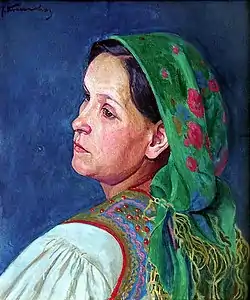Józef Krasnowolski
Józef Krasnowolski (15 November 1879[1] – 29 November 1939[2]) was a Polish painter.

Biography
Krasnowolski was born in Marienwerder ( Kwidzyn ), Province of West Prussia.[2] He was the second son of Antoni Krasnowolski (1855-1911), teacher, philologist and translator, and Augusta von Thumen (d. in 1935).
Krasnowolski first studied art in Warsaw with Wojciech Gerson (from 1896),[2] then in Kraków at Szkoła Sztuk Pięknych with Jacek Malczewski (1898-1900) and with Leon Wyczółkowski (1900/1901). He completed his education by studying in Munich (Germany) (1901–1902).[1]
During an open-air session in the village of Bieńczyce near Kraków, he met his future wife, Salomea Wiktoria Turbas (1882–1957),[3] daughter of wealthy peasant family (Grzegorz and Salomea née Biernacik). The family tradition makes the Turbasa family descendants of captive Tatar cavalry. The wedding took place on 5 November 1902 in the Kraków Church of St Nicolas, the wedding reception in the bride's cottage in Bieńczyce, and gathered the artistic milieu of the city led by Leon Wyczółkowski.
Until 1914 the couple lived in a peasant cottage. They had four sons: Franciszek (16 April 1903 – 19 April 1944), a talented artist who died of tuberculosis; Kazimierz Krasnowolski (teacher and biologist); Witold - the family's adventurer who emigrated to Brazil where for a time he presided over the Union of Poles (Związek Polaków), tried his hand in coffee planting and opening bus lines, and raised nine children (his own and adopted); and Włodzimierz (29 December 1912 – 20 December 1981), a soldier of the Home Army (AK) in the Second World War, when he was made to hide under Stalinist terrorism.
Krasnowolski joined well-known artistic organisations in Kraków, Warsaw, and Vienna,[4] and his works were included in an album of Polish art published in Paris in 1912. He also published a series of post-cards in order to provide additional income.[5] World War I greatly impacted the Polish art market; forced to teach drawing in secondary school and to work for the Polish Telegraphic Agency,[6] he was troubled by poor health. Despite glaucoma and partial paralysis in his hands (beginning in 1926), he continued to paint and to receive awards - the last one in 1934 for Cottage in the Sun.
He became embittered in his last years, when he was forced to draw on the support of his son Kazimierz, who was a young teacher at that time. Despondent by the outbreak of World War II, he died within a few weeks of its outbreak (on 29 November 1939). He was buried at the Rakowice Cemetery.
Work

Krasnowolski's paintings are dominated by peaceful landscapes with blue-and-rusty striped cottages,[1] portraits of young girls in regional costumes (most often it was his wife who did the modelling), and children - especially his own sons. Beginning in 1903 he regularly participated in exhibitions by Kraków's Towarzystwo Przyjaciół Sztuk Pięknych and Warsaw's Zacheta, Poznań, Lvov (Lviv), and abroad: in Prague, Vienna, Munich, Budapest, Kiev, and Dresden.
Highly recognized by the critics and magazines (Tygodnik Ilustrowany, Świat, Sfinks, and Życie i Sztuka), he was most praised for the choice of subject and mood. Especially famous are his Peasant Madonnas in a highly Polish style. His most valued works originated during and after the artist's stay in Paris (1909). This was his time of greatest recognition; he participated in exhibitions with the leading artists of the Młoda Polska (Young Poland) movement, and in 1911 was awarded the highest prize at the 1st Exhibition of Sacred Art in Kraków for his "Heart of Jesus" (today in the altar of the Church in Krzesławice[7]), and a few days later - for the "Four Bathing Boys" (portrait of his sons) in Vienna.
References
- Źródła do dziejów sztuki polskiej (Volume 11). Zakład im. Ossolińskich. 1960. p. 91.
- Muzeum Okręgowe w Toruniu (2000). Kolekcja pakoska: wokol krakowskiej "Sztuki" : katalog wystawy (in Polish). Ratusz Staromiejski. p. 80. ISBN 9788387083236.
- Cavanaugh, Jan (2000). Out Looking In: Early Modern Polish Art, 1890-1918. University of California Press. p. 271. ISBN 9780520211902.
- Cavanaugh, Jan (2000). Out Looking In: Early Modern Polish Art, 1890-1918. University of California Press. p. 75. ISBN 9780520211902.
- "Happy Easter". Polona.
- Grabowski, Waldemar (2005). Polska Agencja Telegraficzna 1918-1991. Polska Agencja Prasowa. p. 164. ISBN 9788391124284.
- Bronisław Cenda; Dominika Cenda (2011). Kościoły, kaplice i dzwonnice drewniane (in Polish). Oficyna Wydawnicza "Rewasz". p. 41. ISBN 9788362460083.